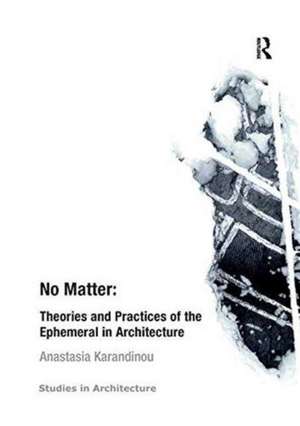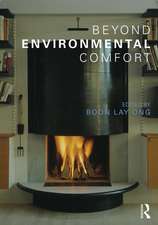No Matter: Theories and Practices of the Ephemeral in Architecture: Ashgate Studies in Architecture
Autor Anastasia Karandinouen Limba Engleză Paperback – 22 dec 2016
| Toate formatele și edițiile | Preț | Express |
|---|---|---|
| Paperback (1) | 338.33 lei 6-8 săpt. | |
| Taylor & Francis – 22 dec 2016 | 338.33 lei 6-8 săpt. | |
| Hardback (1) | 825.63 lei 6-8 săpt. | |
| Taylor & Francis – 23 oct 2013 | 825.63 lei 6-8 săpt. |
Din seria Ashgate Studies in Architecture
- 8%
 Preț: 383.36 lei
Preț: 383.36 lei - 26%
 Preț: 820.71 lei
Preț: 820.71 lei - 22%
 Preț: 329.91 lei
Preț: 329.91 lei - 25%
 Preț: 768.30 lei
Preț: 768.30 lei - 11%
 Preț: 362.88 lei
Preț: 362.88 lei - 12%
 Preț: 325.34 lei
Preț: 325.34 lei - 22%
 Preț: 324.16 lei
Preț: 324.16 lei - 25%
 Preț: 826.84 lei
Preț: 826.84 lei - 25%
 Preț: 776.81 lei
Preț: 776.81 lei -
 Preț: 449.41 lei
Preț: 449.41 lei - 25%
 Preț: 770.31 lei
Preț: 770.31 lei - 25%
 Preț: 823.99 lei
Preț: 823.99 lei - 22%
 Preț: 324.16 lei
Preț: 324.16 lei - 25%
 Preț: 881.28 lei
Preț: 881.28 lei - 13%
 Preț: 338.33 lei
Preț: 338.33 lei -
 Preț: 469.34 lei
Preț: 469.34 lei - 25%
 Preț: 886.47 lei
Preț: 886.47 lei - 12%
 Preț: 328.00 lei
Preț: 328.00 lei - 25%
 Preț: 767.07 lei
Preț: 767.07 lei - 18%
 Preț: 1012.89 lei
Preț: 1012.89 lei -
 Preț: 469.34 lei
Preț: 469.34 lei - 25%
 Preț: 826.43 lei
Preț: 826.43 lei - 26%
 Preț: 850.54 lei
Preț: 850.54 lei - 25%
 Preț: 710.66 lei
Preț: 710.66 lei - 25%
 Preț: 767.67 lei
Preț: 767.67 lei - 13%
 Preț: 338.33 lei
Preț: 338.33 lei - 13%
 Preț: 338.33 lei
Preț: 338.33 lei - 26%
 Preț: 821.82 lei
Preț: 821.82 lei - 26%
 Preț: 821.53 lei
Preț: 821.53 lei - 25%
 Preț: 827.64 lei
Preț: 827.64 lei - 25%
 Preț: 767.93 lei
Preț: 767.93 lei - 26%
 Preț: 821.53 lei
Preț: 821.53 lei - 25%
 Preț: 799.76 lei
Preț: 799.76 lei - 25%
 Preț: 823.08 lei
Preț: 823.08 lei - 25%
 Preț: 826.01 lei
Preț: 826.01 lei - 25%
 Preț: 769.51 lei
Preț: 769.51 lei
Preț: 338.33 lei
Preț vechi: 386.77 lei
-13% Nou
Puncte Express: 507
Preț estimativ în valută:
64.75€ • 67.51$ • 53.81£
64.75€ • 67.51$ • 53.81£
Carte tipărită la comandă
Livrare economică 21 martie-04 aprilie
Preluare comenzi: 021 569.72.76
Specificații
ISBN-13: 9781138267220
ISBN-10: 1138267228
Pagini: 254
Dimensiuni: 174 x 246 mm
Greutate: 0.45 kg
Ediția:1
Editura: Taylor & Francis
Colecția Routledge
Seria Ashgate Studies in Architecture
Locul publicării:Oxford, United Kingdom
ISBN-10: 1138267228
Pagini: 254
Dimensiuni: 174 x 246 mm
Greutate: 0.45 kg
Ediția:1
Editura: Taylor & Francis
Colecția Routledge
Seria Ashgate Studies in Architecture
Locul publicării:Oxford, United Kingdom
Recenzii
'I shall leave you with a wish, a wish to take from this few or many things but best of all take passion for questioning the limits as Karandinou so enthusiastically and enigmatically does'. Building Design online 'The range of empirical case studies used to illustrate the instability of the theoretical divisions ranges from audio projects in Edinburgh, Scotland to performative mapping in Shanghai, China. As a result of both its theoretical basis and its use of case study material, No Matter will interest anyone who wants to know more about the intersection of the built environment around us and the digital world that we use to live our lives.' New Books Network
Cuprins
List of Illustrations, About the Author, Notes by the Author, Preface, Acknowledgements, 1 Vaporizing Architecture, 2 Beyond the Visual versus the Non-Visual: The Sonic and Other Senses, 3 Beyond the Formal versus the Material: The Performative, 4 Beyond the Physical versus the Digital: The Hybrid, 5 Further Questions, Bibliography, Index
Descriere
How do digital media (mobile phones, GPS, iPods, portable computers, internet, virtual realities, etc.) affect the way we perceive, inhabit and design space? Why do architects traditionally design, draw and map the visual, as opposed to other types of sensations of space (the sound, the smell, the texture, etc.)? Architecture is not only about the solid, material elements of space; it is also about the invisible, immaterial, intangible elements of space. This book examines the design, representation and reception of the ephemeral in architecture. It discusses how architects map and examine the spatial qualities that these elements create and questions whether - and if so, how - they take them into account in the designing process.








